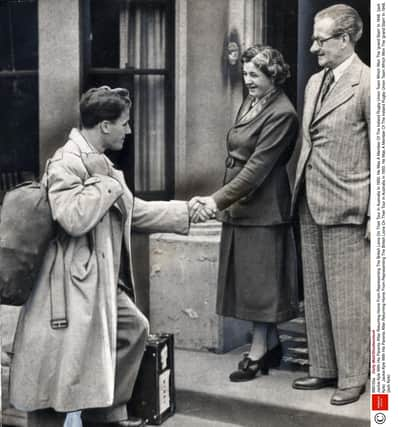Allan Massie: Six months away with 31 players - when a tour was a real adventure


All in all, they played 29 matches, winning 22, drawing one (the first Test against the All Blacks) and losing five. In New Zealand they lost to Otago and Southland and three times to the All Blacks, each match being close. So they won both Tests in Australia. Astonishing as it must now seem, there were a mere thirty-one players in the touring party. Actually they set off with only thirty, but the 19-year-old Welsh star Lewis Jones was flown out as a replacement when the Cardiff fly-half Billy Cleaver was seriously injured. Now the Lions take more than forty players for tours lasting only a handful of weeks rather than almost six months. Players were often required to turn out while nursing injuries.
Fortunately there was no shortage of medical expertise, besides what might be available in New Zealand and Australia. The captain, Ireland’s Karl Mullen, was a doctor, and two powerful backs, the Cardiff centre Jack Matthews and the London Scottish wing Doug Smith (an Aberdeen University graduate) were also doctors. Two of the other Scots, scrum-half Gus Black and wing or centre Ranald Macdonald, were Edinburgh University medical students.
Advertisement
Hide AdAdvertisement
Hide AdThe last two Scots in the party were the Edinburgh Wanderers prop Grahame Budge and Peter Kininmonth, who played his club rugby for Richmond. Douglas Elliot, the outstanding Scottish player of the immediate post-war years, had had to decline the invitation to tour because he couldn’t be away from the family farm from late March to late September. His offer to fly out at his own expense after the Spring lambing was likewise declined.
There were others in Elliot’s position. John Gwilliam, who had captained Wales to a Triple Crown triumph that Spring, was teaching at Glenalmond and unable to get leave of absence for a whole summer term, leave that would indeed have to extend into the first weeks of the Autumn one (five years later the school was more understanding when the Lions s electors invited Jim Greenwood to tour South Africa).
Wales , not surprisingly, in view of that Triple Crown, provided the biggest contingent with 14, including the replacement, Lewis Jones. There were nine Irishmen, the number reflecting Ireland’s success since the war, the five Scots mentioned, and only three Englishmen. It seems a remarkably small number, even if English rugby had scarcely been brilliant since the war.
As would be the case on the next Lions tour of New Zealand nine years later, the Lions backs outshone their opponents, but The All Blacks tended to win the forward battle. New Zealand rugby in the 1950s was efficient and rather dour, rarely sparkling, as we realized when the All Blacks came north in 1953-4. They were a dull team, especially when compared with the1951-2 Springboks.The South Africans had scored nine tries at Murrayfield; New Zealand scored none, winning by the only penalty goal of the game.
Ireland’s Jack Kyle was the brightest star of the 1950 Lions, hailed by New Zealanders as the finest first five-eighth (fly-half) they had seen in a long time, perhaps ever. But there were other fine backs, the Welsh centres, Bleddyn Williams and Jack Matthews, and the Olympic sprinter Ken Jones on the right wing.
Two odd things about the Scottish contingent. Two of them, Budge and Macdonald, had had only one season of international rugby. You might think the experience of the Lions tour would have served Scotland well in the years to come. Not a bit of it. Neither played for Scotland again. My memory is that one of them – I think Budge – emigrated to Canada, and it may be that MacDonald’s medical studies took precedence over rugby, as such things often did in the amateur days. But I wonder. Macdonald incidentally scored a try in his first international, for Scotland against France, and in his last seven or eight months later, for the Lions against Australia. Nor did Gus Black add to the six Scotland caps he had won since 1947. The two for the Lions against New Zealand were the last of his international career. Soon after he was a medical officer in the RAF and playing for Bristol, brilliantly according to Press reports, but ignored by the Scottish selectors. Doug Smith won only one Scottish cap after that Lions tour – against Ireland in 1953.
Peter Kininmonth returned from the tour to captain Scotland in the Spring of 1951,and kick his famous drop-goal from way out under the lee of the old West Stand in that astonishing 19-0 defeat of Wale. The knowledge that there were 13 of his Lions colleagues in that dumbstruck Welsh team must have added a certain savour.
A message from the Editor:
Thank you for reading this story on our website. While I have your attention, I also have an important request to make of you.
Advertisement
Hide AdAdvertisement
Hide AdWith the coronavirus lockdown having a major impact on many of our advertisers - and consequently the revenue we receive - we are more reliant than ever on you taking out a digital subscription.
Subscribe to scotsman.com and enjoy unlimited access to Scottish news and information online and on our app. With a digital subscription, you can read more than 5 articles, see fewer ads, enjoy faster load times, and get access to exclusive newsletters and content. Visit https://www.scotsman.com/subscriptions now to sign up.
Our journalism costs money and we rely on advertising, print and digital revenues to help to support them. By supporting us, we are able to support you in providing trusted, fact-checked content for this website.
Frank O’Donnell
Editorial Director
Comments
Want to join the conversation? Please or to comment on this article.